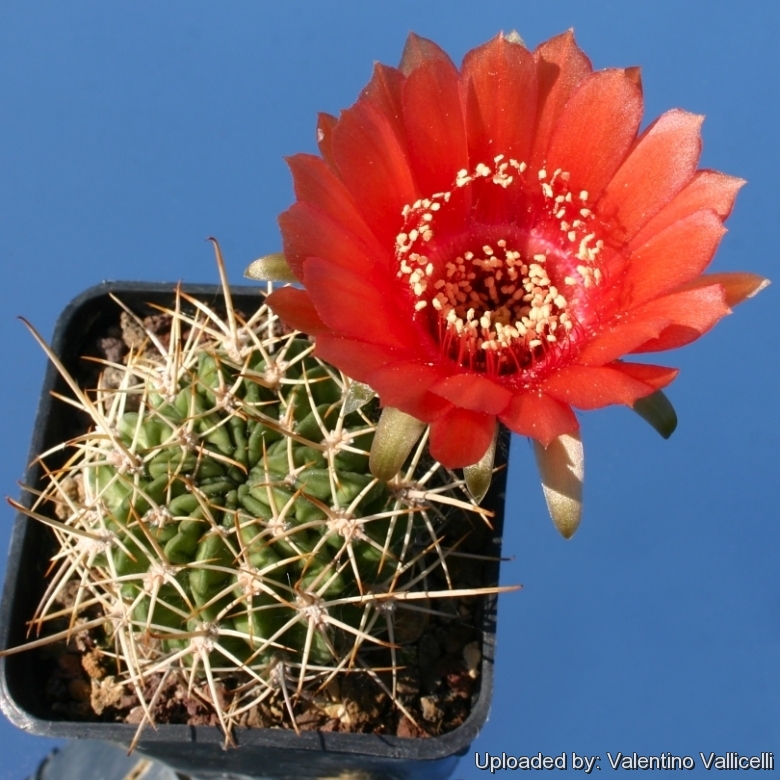
Echinopsis lateritia Photo by: Valentino Vallicelli
(classical form with brick-red flowers)
This is one of the most variable species with several related population that differ widely in flower colour, spine colour, number, length and thickness of central spines, and other characters.
Origin and Habitat: Potosi, Chuquisaca, Tarija (Bolivia) and (?) Jujuy, Argentina.
Lobivia lateritiaSN|21083]]SN|21083]] was collected at the turn of the last century by Fiebrig in Southern Bolivia.
Altitude: 2400-3200(-3700) above sea level.
Synonyms:
See all synonyms of Echinopsis lateritia
back
Accepted name in llifle Database:Echinopsis lateritia GürkeMonatsschr. Kakteenk. 17: 151. 1907Synonymy: 33
back
Description: Lobivia lateritiaSN|21083]]SN|21083]] is a pretty little species, with a low thick flat to cylindrical stem. Plant almost always grows solitary but sometime ramifies from the base to form clusters, size depending on the clone.
Root: Tap root.
Stem: Nearly globular or slightly elongated glaucous green. About 5-8 cm tall.
Ribs: About 18, broad at the base, acute straight or wavy, approx 1 cm high.
Areoles: Felted1-2 cm apart.
Radial spines: 9-10 straight or more or less curved, up to 5 cm long, whitish, yellowish or brownish.
Central spines: 1 to 2 ± longer than the radials curved upward, somewhat thickened at the base sometime slightly hooked. Older plant begins to produce very long spines (up to 10 cm in some clones)
Flowers: Short funnel-formed 3 to 5 cm long, 5-6 cm in diameter, yellow, orange, pinkish, brick-red to carmine in colour with a usual clearer centre. Inner perianth segments oblong, acute. Scales on the ovary and flower tube lanceolate, acute with black hairs in the axil. Filaments yellow to red. Stigma lobes about 7 or 8.
Blooming season: Bloom in the daytime, from late spring to summer and remain open for about three days.
Subspecies, varieties, forms and cultivars of plants belonging to the Echinopsis lateritia group
Notes: The Echinopsis lateritiaSN|21082]]SN|21082]] complex comprises a large number of infraspecific taxa, differing in various combinations of flower colour, spine colour, number and thickness of central spines, and other characters. The taxonomic and geographic boundaries among the segregate species or infraspecific taxa of E. lateritia remain nebulous and controversial. In no place do pure populations exist sympatrically, and all taxa appear completely interfertile.
Bibliography: Major references and further lectures
1) Edward Anderson “The Cactus family” Timber Press, Incorporated, 2001
2) James Cullen, Sabina G. Knees, H. Suzanne Cubey "The European Garden Flora Flowering Plants: A Manual for the Identification of Plants Cultivated in Europe, Both Out-of-Doors and Under Glass" Cambridge University Press, 11/Aug/2011
3) David R Hunt; Nigel P Taylor; Graham Charles; International Cactaceae Systematics Group. "The New Cactus Lexicon" dh books, 2006
4) N. L. Britton, J. N. Rose “The Cactaceae. Descriptions and Illustrations of Plants of the Cactus Family.” Volume 4, The Carnegie Institution of Washington, Washington 1923
 Echinopsis lateritia Photo by: Cactus Art
Echinopsis lateritia Photo by: Cactus Art Echinopsis lateritia Photo by: Cactus Art
Echinopsis lateritia Photo by: Cactus ArtCultivation and Propagation: It is a summer grower species that offers no cultivation difficulties.
Soil: Needs a large pot to accommodate a large root system. Use a very draining and porous substrate that allows therefore roots to breath, since it's natural habitat is in volcanic soil, it has adapted to more acidic conditions.
Water: They like only a short winter's rest and should be kept almost completely dry during the winter months, If the soil is allowed to be dry for too long root loss could follow but equally the same result would occur if the plants are both wet and cold. From March onwards the plant will begin to grow and watering should be increased gradually until late May when the plant should be in full growth. Water regularly during the summer so long as the plant pot is allowed to drain and not sit in a tray of water. During hot weather you may need to water the plants more frequently so long as the plant is actively growing. From late September watering should be reduced to force the plant to go in to a state of semi dormancy, by October you should be back in to the winter watering regime.
Exposure: It needs full sun avoiding only the harshest summer sun, if kept too dark it may become overly lush and greener and could be prone to rotting due to over watering.
Fertilization:Feeding may not be necessary at all if the compost is fresh then, feed in summer only if the plant hasn't been repotted recently. Do not feed the plants from September onwards as this can cause lush growth which can be fatal during the darker cold months.
Hardiness: It is quite frost resistant if kept dry (hardy to -5° C)
Maintenance: They should be re-potted frequently until they attain their desired size.
Pests & diseases: It is especially susceptible to spider mite mealybugs and scales infestation.
Propagation: Propagate by seed or shoots.












